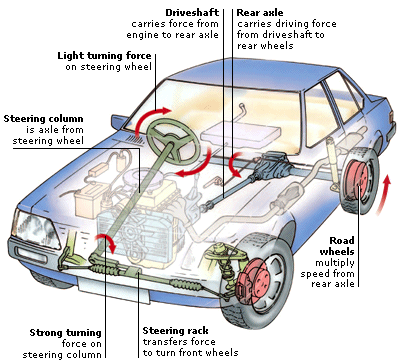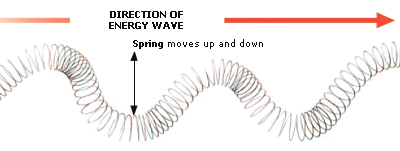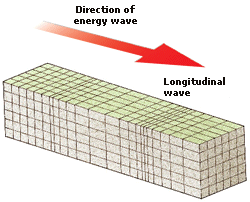11.
RADIOACTIVITY
The atoms of some chemical elements are unstable. They try to rearrange themselves to make more stable atoms. In the process, they give off radiation particles or tiny bursts of radiation. This process is called radioactivity. Although radioactivity can be harmful to people, it can also be important to us in everyday life. It is used to make nuclear energy and preserve food, and it also plays a vital role in the treatment of cancer.
DANGER: RADIATION
Some types of radioactivity are harmful, because they damage or destroy the tissues of the human body. If people receive large doses of radioactivity, they can become ill with radiation sickness, which often causes cancer. Radiation sickness can also affect people’s ability to have children.
TYPES OF RADIOACTIVITY
The three types of radiation are alpha and beta particles, and gamma radiation, named after the Greek letters above. An alpha particle is two protons joined to two neutrons. A beta particle is an electron. Gamma radiation is high-energy electromagnetic radiation.
ALPHA DECAY
An alpha particle is made when the nucleus (central part) of a large, unstable atom rearranges itself, or decays, to make a smaller, more stable atom. The new and smaller atom has two protons and two neutrons fewer than the original atom. These join together to make the alpha particle that is given off. Some energy is also released as a gamma ray. This is high-energy and high-frequency radiation, travelling at the speed of light.
BETA DECAY
Beta decay is quite different from alpha decay. One of the neutrons in the nucleus of the unstable atom changes into a proton and an electron. The proton joins onto the nucleus, but the electron is ejected from the atom at high speed. This fast-moving electron is called a beta particle. Some energy is also released as a gamma ray.
12.
NUCLEAR ENERGY
Atoms are small but can release lots of energy. When an unstable atom changes into a more stable one, it gives off radioactivity. It also gives off some of the potential energy locked inside the nucleus of the atom. Some atoms can be made to produce a constant supply of nuclear energy in a process called a chain reaction. Nuclear energy makes possible the destructive power of nuclear bombs, but it also generates much of the world’s electricity.
NUCLEAR EXPLOSION
When a nuclear bomb detonates, it starts a runaway chain reaction and releases enormous amounts of energy very quickly. A lump of radioactive plutonium the size of a tennis ball can produce as much energy as tens of thousands of tons of powerful explosives.
NUCLEAR FISSION
In nuclear fission (splitting), large atoms break into smaller ones and give off energy. When a neutron is fired at the nucleus of a large atom, the atom becomes unstable and splits into two smaller atoms. Energy is produced and some neutrons are given off too. They collide with more large unstable nuclei of the original material and continue the chain reaction.
NUCLEAR FUSION
In nuclear fusion (joining), massive energy is given off when small atoms fuse together to make larger atoms. A neutron is released at the same time. Stars like the Sun make their energy when nuclear fusion happens inside them at extremely high temperatures and pressures. Scientists are hoping that nuclear power stations will one day use fusion to provide Earth with a clean and inexpensive source of energy.
BIOGRAPHY: LISE MEITNER Austro-Swedish, 1878-1968
Physicist Lise Meitner was one of the first to explain the process of nuclear fission. She also predicted the idea of the nuclear chain reaction before anyone had managed to make it work. She supported development of nuclear power, but opposed the production of nuclear bombs.
13.
ENERGY SOURCES
Everything we do takes energy, which we get from many different sources. Most of the energy on Earth originally came as light and heat from the Sun. It has been stored in fuels such as coal and oil, formed from the fossilized remains of plants or animals over millions of years. Supplies of these fossil fuels are limited. This is why we are now turning to supplies of RENEWABLE ENERGY that never run out. Another alternative is GEOTHERMAL ENERGY, produced deep inside the Earth.
This power station is burning coal to release the chemical energy it contains and produce electricity. The Sun’s energy is converted into carbon-based compounds by plants as they grow. When plants decay, they change into a dark, earthlike substance called peat. Over millions of years, the peat is buried under other material and pressure turns it into coal.
ENERGY FROM THE SUN
Every second, the same amount of energy reaches Earth from the Sun as a coal-fired power station could make from about 200,000 truckloads of coal. The Sun makes energy from nuclear reactions deep inside it. In some ways it is like a giant nuclear power station.
INSIDE A NUCLEAR POWER STATION
Nuclear reactions take place in the fission reactor of a nuclear power station. Coolant (cold water) is pumped around the reactor and is turned to steam by the heat generated by the reactions. The steam drives an electricity-generating machine called a turbine.
RENEWABLE ENERGY
Long after fossil fuels have run out, the tides will still be turning, the wind will still be blowing, and the Sun will still be shining. Ocean, wind, and solar power is called renewable energy because it never runs out. Using renewable energy is better for the environment. Unlike fossil fuels, it produces no harmful pollution and does not add to the problem of global warming.
As the tides ebb and flow, they make water move back and forth in rivers that end in estuaries at the coast. A tidal power generator is a type of bridge that blocks the mouth of an estuary so the tide has to move through it. Each time the water flows in or out, it turns a turbine inside the power generator and produces electricity.
GEOTHERMAL ENERGY
This form of energy is not generated by the Sun. It is made by the nuclear reactions taking place all the time deep inside the Earth. These make heat energy in the Earth’s core, and the heat moves around inside the Earth by convection. Volcanoes and hot geysers release geothermal energy at the Earth’s surface.
GEOTHERMAL PLANT
A geothermal energy plant takes its power from the Earth’s heat. It works by pumping cold water down a hole drilled into the Earth. The Earth’s geothermal energy heats up the water and it returns to the surface as hot water and steam. The hot water can be pumped to homes and factories nearby. The steam is used to drive a turbine and make electricity.
13.
MACHINES
In science, a machine is any device that changes a force into a bigger or smaller force, or alters the direction in which a force acts. Machines come in all shapes and sizes. Large machines such as cranes, bulldozers, and tipper trucks are based on smaller, simpler machines called LEVERS , WHEELS , PULLEYS , SCREWS, and GEARS. Simple tools such as a spade, a knife, a drawing-pin, and a nutcracker are also machines.
LEVERS
Most levers are force multipliers. They reduce the effort needed to work against a force called the load. They magnify a small force into a larger force. When a force acts on an object that is fixed at one point, the object turns around this pivot point. The further away the force is from the pivot point, the easier it is to turn the object. That is how levers make work easier.
TYPES OF LEVERS
Levers can work in three ways. Class one and class two levers turn the effort into a larger force to work against the load. Class three levers work in the opposite way, to reduce the force and increase the control of it over a greater distance.
WHEELS
A wheel and the axle it turns around combine as a machine that works like a lever. The distance between the rim of the wheel and the axle multiplies either speed and distance or force. If the effort is applied to the axle, the rim of the wheel turns further, and so faster, than the axle, but with less force. If the effort is applied to the rim of the wheel, the axle turns with more force but not so far or fast.
 A steering wheel multiplies force because the rim turns further than the steering column. It multiplies your effort and turns the car’s wheels with more force than you actually apply. The road wheels multiply speed. The car’s engine turns the driveshaft and rear axle at a certain speed. The axle turns the large road wheels further and therefore faster.
A steering wheel multiplies force because the rim turns further than the steering column. It multiplies your effort and turns the car’s wheels with more force than you actually apply. The road wheels multiply speed. The car’s engine turns the driveshaft and rear axle at a certain speed. The axle turns the large road wheels further and therefore faster.
14.
ENGINES
Many modern machines, from motorbikes to jet aircraft, are powered by engines. An engine is a machine that turns fuel into movement. The fuel is burned to generate heat energy. The heat is then converted into mechanical power. In a car or motorbike engine, the power comes from pistons and cylinders. In a jet aircraft, power comes from hot gases rushing past a spinning wheel called a TURBINE. Engines also produce various waste gases, which cause pollution.
TURBINES
These are machines that extract and use the energy from a moving liquid or gas. Windmills and waterwheels were the very first turbines. Their sails and paddles took power from the movement of wind and water. Turbines are still important today, especially as they are used in power stations and jet engines.
TURBOJET ENGINE
An aeroplane’s jet engine has one or more large fans at the front. These mix air with fuel and compress the mixture. In the combustion chamber, the fuel ignites, burns, and produces hot gases. As the gases expand, they turn a turbine that spins the fans. The force of the hot gases rushing backwards out of the engine propels the aircraft forwards.
15.
FLOATING
When an object such as a boat or an airship rests in a fluid (a liquid or gas), it has to displace (push aside) some of the fluid to make room for itself. The object’s weight pulls it downwards. But the pressure of the fluid all around the object tries to push it upwards with a force called upthrust. The object SINKS if the upthrust is less than its weight, but floats if the upthrust is equal to, or more than its weight.
FLOATING AIRSHIP
Hot air is less dense than cooler air, so the hot air in a balloon weighs less than the same volume of cool air. The weight of the airship pulls it downwards, but the air around the balloon pushes it upwards with a force called upthrust. If the upthrust is equal to or greater than the total weight of the balloon, the basket, and the hot air, the airship floats.
FLOATING SHIP
When a boat floats, it displaces some of the water underneath it. As the weight of the boat pushes down on the water, the water pushes up on the boat with an upward force called buoyancy. The larger the boat, the greater the buoyancy. The boat floats if the buoyancy is as great as or greater than the weight of the boat.
BIOGRAPHY: ARCHIMEDES Greek, 287-212 BC
Archimedes is best known for realizing that a floating object displaces its own weight in a fluid. Legend has it that he worked this out in his bath. As he stepped into the bathtub, water splashed over the side. He found that the weight of this water equalled his body weight. This idea is known as Archimedes’ Principle.
SINKING
Not everything will float. A block of wood will float on water, but a lump of iron exactly the same size will sink. This is because a piece of wood of a certain size weighs less than the same volume of water, so wood floats on water. However, iron is much heavier than either wood or water. A block of iron weighs more than the same volume of water. This is why iron sinks in water.
PLIMSOLL LINE
The more cargo a ship carries, the deeper it sits in the water. Ships also displace varying amounts of water according to the saltiness and temperature of the water. This varies from ocean to ocean around the world. Large ships have a mark called a Plimsoll line painted on their sides. This shows how much weight they can safely carry in different parts of the world.
16.
ENERGY WAVES
Many different kinds of energy travel in waves. Sound waves carry noises through the air to our ears. SEISMIC WAVES travel inside the Earth and cause earthquakes. Light, heat, radio, and similar types of energy are carried by a variety of waves in the ELECTROMAGNETIC SPECTRUM. Some energy waves need a medium, such as water or air, through which to travel. The medium moves back and forth as waves carry energy through it, but it does not actually travel along with the wave.
 Suppose you fix a slinky spring at one end and push the other end back and forth. Some parts of the spring, called compressions, are squeezed together. Other parts of the spring, called rarefactions, are stretched out. The compressions and rarefactions travel down the spring carrying energy. This type of wave is called a longitudinal or compression wave.
Suppose you fix a slinky spring at one end and push the other end back and forth. Some parts of the spring, called compressions, are squeezed together. Other parts of the spring, called rarefactions, are stretched out. The compressions and rarefactions travel down the spring carrying energy. This type of wave is called a longitudinal or compression wave.
 Suppose you fix the slinky at one end and move it up and down. Energy travels along the spring’s length in S-shaped waves, so the forward direction in which the energy moves is at right angles (or transverse) to the up-and-down direction of the movement of the spring. This is called a transverse wave.
Suppose you fix the slinky at one end and move it up and down. Energy travels along the spring’s length in S-shaped waves, so the forward direction in which the energy moves is at right angles (or transverse) to the up-and-down direction of the movement of the spring. This is called a transverse wave.
When an ocean wave crashes against the shore, it releases a large amount of energy. Ocean waves are transverse waves that carry huge amounts of energy across the surface of the sea as they move up and down. A wave 3 m (10ft) high carries enough energy to power around 1,000 lightbulbs in every 1 m (3 ft) of its length.
BIOGRAPHY: HEINRICH HERTZ German, 1857-1894
In 1887, physicist Heinrich Hertz became the first person to prove that waves carry electromagnetic energy between two places. This extremely important finding eventually led to the development of radio and television. Hertz did not live to see these inventions, however. He died in 1894, aged only 36.
ELECTROMAGNETIC SPECTRUM
Radios, televisions, mobile phones, and radar use signals made up of electromagnetic waves. These are waves that carry energy as electricity and magnetism at the speed of light. Light we can see is also an electromagnetic wave, but other types of electromagnetic wave are invisible. The various types of electromagnetic wave have different frequencies and wavelengths. Together, they make up the electromagnetic spectrum.
GAMMA RAYS
These are produced by radioactivity. They have a short wavelength and a high frequency and carry large amounts of energy. They are very harmful and can cause cancer in humans and animals.
ULTRAVIOLET RAYS
These invisible waves are slightly shorter than visible violet light and carry more energy. We wear sunglasses and sunblock to prevent damage to our eyes and skin by ultraviolet rays.
INFRARED RAYS
Infrared rays are slightly longer waves than visible red light. Although we cannot see infrared, we can feel it as heat. When heat energy is transferred by radiation, it is carried by waves of infrared.
RADAR
Radar is a way of locating aeroplanes and ships using a type of radio waves called microwaves. These have much longer wavelengths than visible light. Cooking is another use for microwaves.
RADIO WAVES
Radio waves are the longest in the spectrum. They carry radio and TV signals around Earth. Radio waves from outer space are picked up by radio telescopes and used in studies of the universe.
SEISMIC WAVES
When the energy stored in rock deep inside the Earth is suddenly released, it travels up to the Earth’s surface in huge seismic shock waves. The waves move along weaknesses in the rock known as faults. As they do so, they produce violent shaking of the ground and an earthquake. The largest earthquakes can release as much energy as a small atomic bomb.
 Some seismic waves are longitudinal or compression waves called primary or P-waves. They cause damage by pushing and pulling things back and forth in the same direction that the wave travels. P-waves move extremely quickly through the Earth’s interior at a speed of about 25,000 kph (15,500 mph).
Some seismic waves are longitudinal or compression waves called primary or P-waves. They cause damage by pushing and pulling things back and forth in the same direction that the wave travels. P-waves move extremely quickly through the Earth’s interior at a speed of about 25,000 kph (15,500 mph).
Earthquakes kill around 10,000 people every year worldwide. Many cities now have buildings that absorb the energy in seismic waves. They may wobble, but they do not collapse.